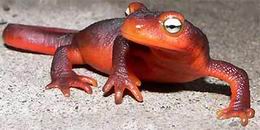October 30, 2005
California Newt. Taricha torosa

Scientific Name: Taricha torosa
Other Common Names: Pacific Coast Newt, Western Newt
Total Length: 5-7.75 inches
Range: Coastal and Sierra Nevada ranges of California
Habitat: They may be found in streams, lakes, ponds, and surrounding coniferous and deciduous forests. They are often found on land under rocks and logs.
Sex Determination: The males’ skin become smooth during the mating season. They also develop a swollen cloacal region, blackish horny toe tips, and a large tail fin.
Reproduction: California Newts return to their home ponds in the winter and spring to breed. The males arrive first at the pond, swimming around until a female arrives. Males remain in the majority because females are capable of breeding only every two or three years.
During mating, the male grasps the female from above and begins to mate. Like all other western newts, fertilization takes place inside the body.
When the time comes to deposit her eggs, the female moves into shallow water along the edge of the pond. She lays 7-29 eggs individually or in clumps to a suitable substrate and immediately returns to terrestrial life. Males remain in the water for quite some time after spawning.
The eggs are round, about 1/8 inch in diameter, and has two colors. The upper half is a light brown; the lower part is white. The eggs hatch in one to two months.
[snip left][/snip]
Metamorphosis: As the newt inside the egg begins to grow, the egg grows longer in length. This is the first sign of development. At the end of two or three weeks, the outline of the baby newt is visable and in four to six weeks the newt is ready to break out of it’s egg.
The larvae metamorphose in the fall or the following spring at the size of three inches. Its forelegs appear at the time of hatching, and its hindlegs appear shortly after that. The young newt has a set of feathery gills, which it uses to breath. Before it leaves the water, the gills are absorbed. Now it must rise to the surface regularly in order to breath. A young California Newt does not look like the adults. It is striped, with black dots.
Keep the baby newts in water for their first year and put them on land for their second and third year. After that, alternate periods on land and in water.
Care In Captivity:
- Tank Size: A maximum of four newts in a 10 gallon tank would be alright.
- Substrate: We suggest that you use a half land and half water set up (an aqua-terrarium). We did this by separating the land from the water with a piece of plexi-glass. We also used a commercial aqua-terrarium set up called the Viquarium. We set it up on April 3, 1997 and so far it is working great. The substrate that you can have on the land side is gravel or soil. On the water side you can have gravel or no substrate like us. Having no substrate makes the water side much easier to clean. You may just put them in a damp terrarium which can have a substrate of gravel or rocks. But in the spring they’ll have to be put in the aqua-terrarium set up.
- Decorations: You can have a log, bark, sticks, rocks, sphagnum moss, and fake plants in the tank. You can use live plants if you like, but you will have to replace them when they die. The water should include something for them to climb out like cork bark or a big fake plant.
- Water: The water should definately have a filter. Depending on the size of the tank will decide on which filter you should use. A bottom filter would probably be best to use but if you have yours in a large tank, a power filter may be better. You should also have a water thermometer.
- Tank Lid: You can have a flip top lid, a screen, or any other type of lid on the tank. There should be good ventilation.
- Heating: You can use a heat rock, a heating pad, or an electric blanket to heat the tank.
- Lighting: No additional lighting is needed but you may use a bulb with ultraviolet radiation if you want.
- Temperature/Humidity: The air temperature should be 55-72 degrees F. In the winter, two months at 37-39 degrees F will stimulate hibernation. Doing this makes them healthier and encourages them to breed. If you decide to do this, then take care of them properly or they may refuse to eat and go back in water next spring. You should have an air thermometer in the tank. They don’t need much humidity. You may use a humidity gauge which will show you how much humidity is in the tank.
- Feeding: The diet should have variety. Feed them tubifex worms, earthworms, slugs, spiders, and other small invertebrates.
- Maintenance: Keep the tank clean and change the filter fiber and ammo-carb in the filter when needed (about every 1.5 months).
Other Information: When they are bothered, California Newts sometime arch their bodies and raise their head and tail to display their bright colors on their bellies as a warning to try and scare you away.
They spend about one year in the water after hatching then stay on land for the next two years. When they are living on land, their skin is usually rough and warty. In the water their skin is much smoother. Once they take to the water, they develop swimming fins on both the top and bottom of their tail.
[snip center][/snip]
